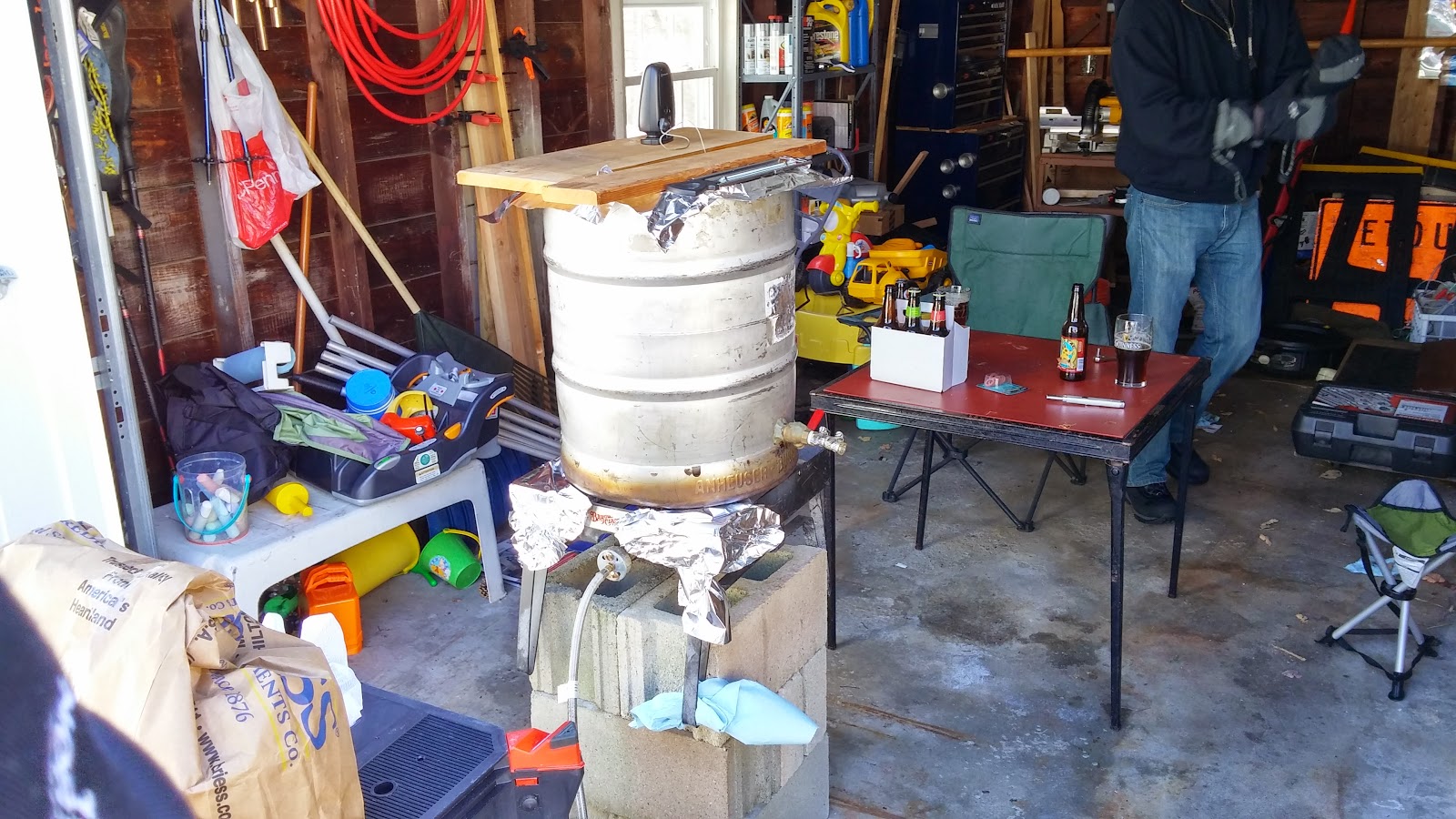Ingredients
We took our previous all-grain brown recipe and, based on the tasting notes, adjusted it slightly. Likewise, it was converted to extract ingredients.
- 15 lbs 2-row malt
- 1 lbs Special B Malt
- 3 lbs Crystal 20°
- 0.5 lbs. Chocolate Malt
- 1oz Northern Brewer (9.6% AA)
- 1oz Fuggles (3.8% AA)
- White Labs British Ale Yeast WLP005
- White Labs N. Yorkshire Square Yeast WLP037
Mash Method
03/22/2015
Well, because we don't have our HERMS setup back in action since it was dismantled long ago, the only way for us to do all-grain was to try our hand at Brew-In-A-Bag, or BIAB for short. This consists of emptying your grain into a large nylon sack, which you put into your strike water directly in the boil pot, and mash like so. Because we're doing a 10 gallon batch, though, we needed two bags since we couldn't find one large enough for our grain bill.
Typicall a BIAB setup leaves the bag open with the top folded over the lip of the boil pot. Since we're using two bags, we can't do that, so we had to tie them off and let them steep in the water.
 |
| Waiting for strike temperature |
We laboriously heated our strike water of 8.5 gallons to 170°F, and added our bags of malt. Unfortunately, it appeared that the measured strike temperature might have been a relative cold spot in the pot because, when we added the grain and mixed, the temperature read 176°. We struggled for about ten minutes to get it below 160°. Once it reached 158°, we turned the gas back on very very lightly and were then able to maintain a mash temp of 154° - 155° for the remainder of the hour.
Unfortunately, due to our need to have two bags floating in the pot, they had to be tied off. We simply tied the bags off instead of using something like butcher twine. This therefore greatly reduced the internal volume of the bags, leaving little to no room for the grain (and therefore alpha amylase) to move around.
Well, when the hour was up, we got 3.5 gallons of 170° water in the 5gal bucket, and popped one of the bags into it. We mixed it around in there as a sort of sparge, then squeezed as much out of the bag as we could without burning ourselves. The new wort was added to the boil pot. This was repeated for the other grain bag as well, and the grains were then discarded into the compost pile.
Brew Method
03/22/2015
After we finished our form of sparging, we ramped the burner up to 11 and got ourselves a rolling boil relatively quickly. We performed an hour boil, with the following hop schedule:
- 0.5oz Northern Brewer, 60 minutes
- 0.5oz Northern Brewer, 30 minutes
- 1oz Fuggles, 15 minutes
We forgot to add Irish Moss for this brew as is standard for all of our brews. However, according to this exBeeriment, it might not be all that necessary anyway.
 |
| Mmmmm worty wort |
Anyways, once the hour was up, we killed the heat and whirlpooled the wort to attempt to settle out any hop trub, hot break, and grain grist. We then hooked up the counterflow chiller, and took our OG reading: 1.044. We'd hoped for 1.046, accounting for a 67% brewhouse mash efficiency. Our actual OG accounts for ~64%. Read about possible reasons here.
Fermentation
3/22/2015
Both 6.5gal fermenters are set up in the basement with blowoff hoses, ready to get bubbling.
3/28/2015
Hmm... no krausen. Got two more vials of yeast and pitched.
4/18/2015
Opened up both fermenters. Still no krausen on either. The WLP037 carboy smelled and tasted great, FG = 1.012. 4.0% ABV. The second one smelled and tasted soury / cidery. It certainly attenuated to 1.010, but not from the yeast, it would seem. Sadly we had to dump it down the drain.
Racked the first 5.5 gallons to secondary.
Bottling
Tasting Notes
MM/DD/YY
Tasting notes

No comments:
Post a Comment